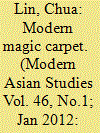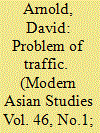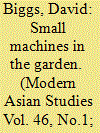|
|
|
Sort Order |
|
|
|
Items / Page
|
|
|
|
|
|
|
| Srl | Item |
| 1 |
ID:
118895


|
|
|
|
|
| Publication |
2012.
|
| Summary/Abstract |
That technology matters-and matters profoundly-to the humanities and social sciences is no longer in dispute. But exactly how it informs our understanding of society, now and in the past, remains a matter of scholarly contention. It might be argued that, as the history and sociology of technology moves away from its principal point of origin in the study of Euro-American societies, the questions that technology poses have, if only by virtue of their relative novelty, a particular resonance for the constituent regions of modern Asia-and not least for the societies of South and Southeast Asia that form the subject of this special issue. It is not a question of adopting an approach as unsubtle and outmoded as technological determinism, or of simply extending to one corner of the Asian landmass a set of 'global' theories and histories, with technology as their underpinning, already established and familiar in other contexts. Rather, it is a case of finding and developing a perspective on technology which helps to illuminate the inner histories and local narratives of these regions and which brings to the wider discussion of technology something distinctive, distilled from the outlook and experience of one part of the non-Western world. A desire to move beyond scholarship's still-dominant paradigms of colonialism, nationalism, and development, to explore the multivalent nature of 'everyday life' and enquire into 'the social life of things' as locally constituted, to examine modernity's diverse material forms, technological manifestations, and ideological configurations, to locate the regional roots as well as the exogenous origins of social change and cultural transformation, to situate subaltern experience alongside middle class mores and elite appropriation-all these interlocking considerations have begun to form part of a collective inquiry into the technological histories and cultures of South and Southeast Asia. A scholarly search is clearly under way to establish new methodologies and meanings, new contexts, and conjunctures, which will inform and reinvigorate the history, sociology, anthropology, and geography of these regions and redefine their place within the burgeoning field of science and technology studies.
|
|
|
|
|
|
|
|
|
|
|
|
|
|
|
|
| 2 |
ID:
118902


|
|
|
|
|
| Publication |
2012.
|
| Summary/Abstract |
Wireless radio broadcasting in colonial Singapore began with amateur organizations in the early 1920s, followed by commercial ventures and, finally, the establishment of a monopoly state broadcasting station. Listeners followed local broadcasting as well as international short wave radio. Both participants in and the content of radio reflected the multiracial, cosmopolitan make-up of a colonial port city which functioned through the lingua franca of English. The manner in which early broadcasting developed in Singapore sheds light on the creation of different imagined communities and the development of civil society. There was an increasing presence of non-Europeans, women, and youth, many of whom were drawn by the mystique of this new technology. Wireless radio also brought about a transformation in the public soundscape. These themes contribute to our understanding of the global history of radio as well as the nature of colonial societies within the British empire.
|
|
|
|
|
|
|
|
|
|
|
|
|
|
|
|
| 3 |
ID:
118903


|
|
|
|
|
| Publication |
2012.
|
| Summary/Abstract |
From the late nineteenth century onwards, a new range of European and American technologies, powered by electricity and gas, and intended for use on the body and in the home-especially appliances for the domestic kitchen-began to appear in Manila. Electro-mechanical vibratory devices and steam-powered massagers for the body; hair waving and curling machines; and a multitude of technologies for the domestic kitchen, from stoves and water heaters to a gamut of electric and gas gadgetry that included percolators, boilers, electric waffle-irons, grills, and refrigerators (or ice-boxes, their precursor) were targeted largely at the affluent female consumer with promises to improve her physical appearance and health or make her daily life more comfortable. Their introduction and impact in the Philippines can tell a number of compelling stories-the desirability of European or American bourgeois culture, how the trappings of Western lifestyles were imagined, the extent to which the use and purchase of certain technologies aimed at replicating or emulating those lifestyles, or, as this paper explores, the gendered technological infrastructure of the 'good life'. In this story, modern technologies designed for domestic settings and for use on women's bodies made manifest a myriad of desires and aspirations-prestige, status, cosmopolitanism, modernity, and urbanity. They also articulated a particular sensuousness and pleasure. Electro-vibratory devices, hair styling machines, and kitchen appliances could be experienced by all the senses and thus exerted a visceral appeal; their use proclaimed an enthusiasm for modern technology which, for the first time, emphasized the relevance of modern technology to women's everyday lives by the transformative effects they promised.
|
|
|
|
|
|
|
|
|
|
|
|
|
|
|
|
| 4 |
ID:
118900


|
|
|
|
|
| Publication |
2012.
|
| Summary/Abstract |
In India in the early twentieth century the modern socio-technological phenomenon of traffic brought together many visible and accessible forms of everyday technology. However, in India modern motorized transport had to operate alongside earlier, seemingly 'pre-modern', modes of street-life. The emergence of traffic helped foster the expansion of late-colonial policing and the growth of the 'everyday state'. It stimulated a new sense of a middle class identity and the proper ordering and disciplining of those who used the modern highway. But the technology of traffic was also contested-by those who evaded traffic rules as well as by those who were critical of technological modernity or the rising human cost of traffic accidents. The street at times became a site of open opposition to state authority or, through the deliberate disruption of traffic, a significant location for the exercise of political defiance and control.
|
|
|
|
|
|
|
|
|
|
|
|
|
|
|
|
| 5 |
ID:
118896


|
|
|
|
|
| Publication |
2012.
|
| Summary/Abstract |
This paper examines the relationship between rubber plantations and changes in everyday technologies in rural Indochina. It also explores the effects that improvement projects had on the countryside in which those who were targeted by these programmes lived. Speeches given at the opening of the B?n Cát agricultural school in Th? D?u M?t province in 1918, for example, show that this school was designed both to train Vietnamese assistants to work on large agricultural exploitations and to improve native agricultural practices. Officials used journals, such as the bilingual French-Vietnamese Cochinchine Agricole, which appeared between 1927 and 1930, to popularize latex-producing science and techniques. Though their motivations often differed from those of officials, the Vietnamese elite, ranging from those in the anti-colonial Duy Tân H?i (Modernisation Society) to French-trained physicians, scientists, and engineers, also often sought to address the problems of rural southern Vietnam through improvements in everyday agricultural technologies. This paper suggests that plantation agriculture, which structured the everyday meanings of rubber in Vietnam, along with the failures of native improvement, began to weaken the support of the Vietnamese elite for the colonial regime during the 1930s. Uneasy compromises and contradictions meant that neither economic profit nor social improvement alone existed in the rubber-producing industry.
|
|
|
|
|
|
|
|
|
|
|
|
|
|
|
|
| 6 |
ID:
118904


|
|
|
|
|
| Publication |
2012.
|
| Summary/Abstract |
This paper takes as its subject the 1905 opening and 1990 closure of the Northern Railway Line, the major Sri Lankan railway which ran the length of the island from south to north. It argues that it can been seen as a social compact in which the life of the individual, the community, and the state became integrally intertwined. It focuses on two dimensions of what the Northern Railway Line enabled in Sri Lanka (formerly Ceylon): first, a physical and symbolic representation of stateness, and, secondly, the pursuit of mundane everyday life. These are embedded within Sri Lanka's landscapes and histories of colonial and post-colonial rule, and the ethnic conflict, riots, and war which inextricably shaped the railway's journeys and passengers. Railways are more often thought of as large-scale, high-tech artefacts rather than the smaller everyday technologies that are the themes of other papers in this special issue. However, this paper highlights the ways in which railways also make particular kinds of everyday life possible and how, in being woven into routine daily and weekly journeys, the Northern Railway Line came to intertwine the changing circumstances and histories of its mainly Tamil passengers within an increasingly ethnicized national landscape. In the aftermath of its closure, the railway has now come to symbolize a desire for a return to the normalcy of the past, an aspiration to an everyday experience that younger generations have never had, and which has, in consequence, become a potent force.
|
|
|
|
|
|
|
|
|
|
|
|
|
|
|
|
| 7 |
ID:
118898


|
|
|
|
|
| Publication |
2012.
|
| Summary/Abstract |
Everyday technologies of the nineteenth century-mass-produced items that were small, sturdy, and affordable-transformed the daily lives of working people in Asian colonies. There is already a large literature on colonial technology transfer and a specialist literature on the sewing-machine, which draws on Singer archives, production figures, sales techniques, and advertising to establish uptake by households from North America to the Philippines, India, China, and Egypt. Still, documentation of how and why imported objects such as the sewing-machine were appropriated is difficult to find because, unlike elites, ordinary people left few records of their own. Here a visual archive is investigated to complement existing studies. Photographs and early moving pictures from the former Dutch East Indies show that ordinary Indonesians sought and appropriated imported goods such as the sewing-machine. The colonial camera's visual record of sewing-machine operators displaces attention from the more impersonal trade and productivity statistics. It brings the silent user into the history of technological uptake and allows us to consider the repercussions across a wide social band and period. Indigenous tailors and seamstresses expanded their own work options. Through the Singer they fitted out and launched their compatriots into modern jobs and lifestyles in the Dutch colony. The sewing-machine changed habits, manners, and expectations; machine operators influenced senses of propriety, fashion, and status. Appropriation of mundane technology demonstrates that modernization was not only a process trickling down to the masses from Westernizing elites; it also bubbled up from below.
|
|
|
|
|
|
|
|
|
|
|
|
|
|
|
|
| 8 |
ID:
118897


|
|
|
|
|
| Publication |
2012.
|
| Summary/Abstract |
Twentieth-century industrialization in the agricultural landscapes of the Mekong Delta in Vietnam took a very different form from other places, characterized less by a continuous spread of large-scale technology than by its destruction in mid-century and the subsequent spread of small technology which powered scooters, water pumps, and boats. The numbers of these portable motors, an everyday technology in 1960, rose from a few thousand units in 1963 to millions in the present day. The colonial and post-colonial state in Vietnam played a key role in the demise of large technology and, ultimately, of the water infrastructure. Its failures during wartime spurred farmers to adopt cheap, small engines to survive; however, the state's role was complex during this time. Several key factors, including the influence of American aid programmes and the contributions of Taiwanese agricultural advisers, especially those pushing high-yield rice, favoured the adoption of small engines. From an ecological viewpoint, the post-1960 explosion in the use of small motors, especially as water pumps, has brought people and states in Southeast Asia to an ecological impasse as unrestricted use has impacted on water tables, salinity levels, and the long-term sustainability of agriculture in many places. This paper examines the state's indirect role in shaping this silent revolution, and it considers the political and ideological factors underpinning its history.
|
|
|
|
|
|
|
|
|
|
|
|
|
|
|
|
| 9 |
ID:
118901


|
|
|
|
|
| Publication |
2012.
|
| Summary/Abstract |
Compared with other public media, the colonial state showed a relative lack of interest in radio broadcasting, which developed in Vietnam in the 1930s under the aegis of two organizations based in Hanoi and Saigon, the Radio-Club de l'Indochine du Nord and Radio Saigon. These two groups were largely responsible for the new technology's expansion and for determining the content of broadcasting. The groups actively consulted the growing radio public, and that vocal audience played a role in determining not just what was heard but also in the social life of radio in late-colonial Vietnam. The content of radio was limited to a non-political domain and this fact, along with the particular position that many radios took in the social geography of towns and cities, lent itself to the easy entry of the radio into day-to-day life. Indeed, the early history of radio in Vietnam is remarkable for how rapidly it became commonplace, even banal.
|
|
|
|
|
|
|
|
|
|
|
|
|
|
|
|
| 10 |
ID:
118899


|
|
|
|
|
| Publication |
2012.
|
| Summary/Abstract |
Around the turn of the twentieth century, electric tramways made their appearance in the cities of Asia, but despite being a universal technology, and despite the considerable impact they had upon life in these cities, the history of tramways in Asia has hardly ever been studied. Trams, wherever they ran, mobilized the urban population to a degree unseen before-their track network could restructure the urban topography and re-evaluate its segments, as independent villages became suburbs and residential quarters rose or fell in status, and add to the segregation of workplaces and residential areas. The two cities of Singapore and Rangoon, which have been selected because of their comparability, provide two contrasting examples of how trams functioned and eventually failed in an Asian urban environment.
|
|
|
|
|
|
|
|
|
|
|
|
|
|
|
|
|
|
|
|
|